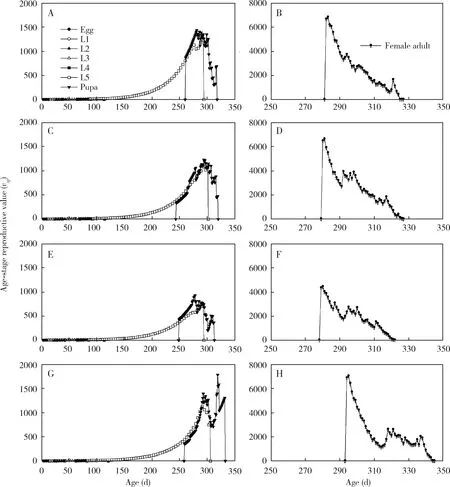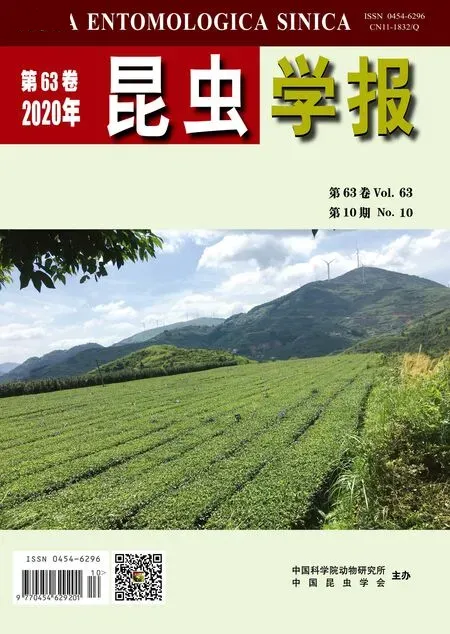Evaluation of the reproductive potential of Clania variegata (Lepidoptera:Psychidae),an serious garden defoliator, on four host plants
CHEN Qi,WANG Rui,WEI Ya-Juan,LIU Jian-Jun,*
(1.College of Landscape Architecture and Art,Northwest A&F University,Yangling,Shaanxi 712100,China; 2.College of Forestry,Northwest A&F University,Yangling,Shaanxi 712100,China; 3.Department of Agriculture and Rural Affairs of Shaanxi Province,Xi′an 710007,China)
Abstract:【Aim】 Clania variegata (Lepidoptera:Psychidae) is a major defoliating pest on several tree species worldwide.In order to control this pest through wise arrangement of plant species in gardens and parks,we evaluated the reproductive potential of C.variegata on four host plants (Platanus acerifolia,Osmanthus fragrans,Albizia julibrissin and Amygdalus persica).【Methods】 The duration of egg,larval and pupal stages,survival rate,adult longevity,oviposition period of female adult and daily number of eggs laid per female of C.variegata on P.acerifolia,O.fragrans,A.julibrissin,and A.persica were recorded in a natural open environment,in Shaanxi Province,northwestern China,from July 15,2018 to June 21,2019.The data of developmental duration,survival rate,adult longevity,and female fecundity were analyzed by the age-stage,two-sex life table theory,using TWOSEX-MSChart software.【Results】 The developmental duration and adult longevity of C.variegata were significantly affected by the host plant species.The duration of the 2nd,3rd,4th and 5th larval instars of C.variegata on O.fragrans was significantly longer than that on the other host plants.C.variegata adult females exhibited significantly greater longevity on A.persica (11.47 d) than on O.fragrans (10.26 d).The oviposition period of C.variegata on O.fragrans (7.04 d) was significantly shorter than those on P.acerifolia (7.52 d),A.julibrissin (7.59 d),and A.persica (8.11 d).The net reproductive rate (R0) of C.variegata on P.acerifolia (2 015.70 eggs) was significantly higher than those on O.fragrans (1 419.12 eggs),A.persica (1 289.66 eggs),and A.julibrissin (976.67 eggs).The intrinsic rate of increase (r) of C.variegata on P.acerifolia (0.02523/d) was significantly greater than those on O.fragrans (0.02377/d),A.julibrissin (0.02304/d),and A.persica (0.02194/d).【Conclusion】 The reproductive potential of C.variegata on P.acerifolia was significantly greater than those on O.fragrans,A.julibrissin,and A.persica.Alternate planting of O.fragrans,A.julibrissin,and A.persica might help reduce the damage of C.variegata to non-preferable plants.
Key words:Clania variegata;Platanus acerifolia;Osmanthus fragrans;Albizia julibrissin;Amygdalus persica;reproductive potential;fecundity
1 INTRODUCTION
Claniavariegata(Lepidoptera:Psychidae) is a major defoliator pest,damaging several landscape and fruit trees.Its host range includes,but is not limited to,sycamore (Platanusorientalis),peach (Amygdaluspersica),sweet-scented osmanthus (Osmanthusfragrans),silk tree (Albiziajulibrissin),tea (Camelliasinensis),mulberry (Morusalba),apple (Maluspumila),pear (Pyrusspp.),plum (Prunussalicina),apricot (Armeniacavulgaris),grape (Vitisvinifera),chestnut (Castaneamollissima),walnut (Juglansregia),persimmon (Diospyroskaki),loquat (Eriobotryajaponica),citrus (Citrusreticulata),longan (Dimocarpuslonggana),paulownia (Paulowniafortunei),robinia (Robiniapseudoacacia),elm (Ulmuspumila),poplar (Populustomentosa),and willow (Salixbabylonica) (Qiaoetal.,1994;Juetal.,2004;Zhang,2010).This pest is widely distributed in China,North Korea,Japan,Vietnam,Laos,Thailand,India,Sri Lanka,Malaysia,Indonesia and Australia (Zhang,2010).C.variegatahas been documented in most provinces in China,including Henan,Hebei,Shaanxi,Shanxi,Tibet,Zhejiang,Jiangsu,and Shandong (Qiaoetal.,1994),and Changchun City of Jilin Province representing the northernmost collection point (Zhang,2010).
Previous studies have assessed the extent of damage (Zhang,2010),host range (Chen and Fan,2016),effective accumulated temperature (Tianetal.,1993),occurrence (Yangetal.,1997),biological features (Wan and Wan,1983),sex pheromones (Zhao,1988),and antenna sub-structures (Zhaoetal.,1986) ofC.variegata,for developing chemical and biological control measures against this pest of landscape plants (Juetal.,2004).However,studies on the biological and ecological characteristics ofC.variegataunderlying its precise population dynamics in the natural environment are scarce.Therefore,in this study we evaluated the developmental duration,survival rate,adult longevity,fecundity,and intrinsic rate of increase (r) ofC.variegataon four host plants,Platanusacerifolia,Osmanthusfragrans,Albiziajulibrissin,andAmygdaluspersica,in the natural environment,in Shaanxi Province,northwestern China,from July 15,2018 to June 21,2019.Our results are expected to contribute to the design and management of gardens and parks,by reducing alternative host plants,for effective control of this pest.
2 MATERIALS AND METHODS
2.1 Insect rearing
C.variegataindividuals were collected initially from the campus of Northwest A&F University,Yangling,Shaanxi,China,in 2017,and then reared in greenhouses of College of Landscape Architecture and Art of the university.The larvae were then transferred onto 3-year-oldP.acerifolia,O.fragrans,A.julibrissin,andA.persicaplants,at 28℃,70% relative humidity (RH) under a photoperiod of 14L∶10D,until pupation.The pupae were maintained on trees until emergence.Adult males searched for adult females at night for mating.AdultC.variegatafemales laid eggs at the opening of the protective bag.The eggs were collected daily and placed on wet black papers to maintain a constant humidity (70%) until hatching.
2.2 Life table analysis
Fifty eggs (72 h-old) were selected randomly from the colony consisting of an equal ratio (1∶1) of females and males,from each of the four tree species for life table assessment.These egg clusters were then placed carefully on a piece of wet black paper (5 cm×5 cm) to maintain humidity.After hatching,each larva was transferred onto a new 3-year-old tree,to feed on the 5-10-day-old leaves.Each tree was maintained in a nylon bag (60 meshes:40 cm×40 cm×100 cm).Larval development was monitored and recorded until adult emergence or death at any larval or pupal stage.The emerged female and male adults were paired.If sufficient adult males were not available,other adult males on the same plant were used to ensure that each adult female could mate once.Then 27,23,17,and 19 adult pairs ofC.variegatawere introduced ontoP.acerifolia,O.fragrans,A.julibrissin,andA.persica,respectively.Eggs were collected daily from the female protective bags.Adult longevity and fecundity (number of eggs laid per female) were also recorded daily.All eggs,larvae,pupae,and adults were maintained in an open garden environment (34°16′56.24″N,108°4′27.95″E) at Northwest A&F University,Yangling,Shaanxi.The experiment commenced on July 15,2018 and concluded on June 21,2019.
2.3 Data analysis
The raw data for eachC.variegataindividual,including developmental duration,survival rate,adult longevity,and female fecundity,were analyzed by the age-stage,two-sex life table theory,using TWOSEX-MSChart software (Chi and Liu,1985;Chi,1988,2018).The age-stage-specific survival rate (sxj),age-specific survival rate (lx),age-stage-specific fecundity (fxj),age-specific fecundity (mx),net reproductive rate (R0),intrinsic rate of increase (r),finite rate of increase (λ),age-stage life expectancy (exj),reproductive value (vxj),and mean generation time (T) were calculated,following Chi and Liu (1985).Here,xandjindicate the age and stage,respectively (Chi,2018).
3 RESULTS
3.1 Age-stage,two-sex life table of C. variegata on four host plants
The age-stage-specific survival rate (sxj) indicated the precise survival rate of the tested population at agexand stagej.Due to the different developmental rates of individuals ofC.variegata,thesxjvalue exhibited partial overlaps (Fig.1).

Fig.1 Age-stage-specific survival rates (sxj) of Clania variegata on Platanus acerifolia (A and B),Osmanthus fragrans (C and D),Albizia julibrissin (E and F),and Amygdalus persica (G and H)L1-L5:1st-5th instar larva,respectively.
The mean developmental duration,adult longevity,and female fecundity ofC.variegatawere shown in Table 1.The egg duration,entire larval duration,and pupal duration ofC.variegataon the four host plants were significantly different.Adult females exhibited significantly greater longevity onA.persica(11.47 d) than onO.fragrans(10.26 d).Adult males exhibited considerably greater longevity onP.acerifolia(2.94 d) than onA.persica(2.62 d),A.julibrissin(2.21 d),andO.fragrans(2.14 d).

Table 1 Development and fecundity of Clania variegata on Platanus acerifolia, Osmanthus fragrans,Albizia julibrissin,and Amygdalus persica
3.2 Fecundity of C. variegata on four host plants
The oviposition period ofC.variegataonP.acerifolia,O.fragrans,A.julibrissin,andA.persicawas 7.52,7.04,7.59,and 8.11 d,respectively.The oviposition period ofC.variegataonO.fragranswas significantly shorter than those onP.acerifolia,A.julibrissin,andA.persica.The fecundity ofC.variegatadecreased significantly,depending on the host plant species,in the order of:P.acerifolia(3 732.78 eggs laid per female per day)>A.persica(3 393.84 eggs laid per female per day)>O.fragrans(3 085.04 eggs laid per female per day)>A.julibrissin(2 872.53 eggs laid per female per day).
The age-specific survival rate (lx) represents the probability that a laid egg will survive to agexand was calculated by pooling all individuals of both sexes in the present study.ThelxofC.variegataonP.acerifolia,O.fragrans,A.julibrissin,andA.persicadecreased gradually with increasing age (Fig.2).

Fig.2 Age-specific survival rates (lx),age-stage-specific fecundity (fx8),age-specific fecundity (mx),age-specific net fecundity (lxmx) and cumulative reproductive rate (cumu.Cx) of Clania variegata on Platanus acerifolia (A and B), Osmanthus fragrans (C and D),Albizia julibrissin (E and F) and Amygdalus persica (G and H)
The age-stage-specific fecundity (fx8,adult as the 5th stage life) ofC.variegataonP.acerifolia,O.fragrans,A.julibrissin,andA.persicawas 797.00,865.00,507.00,and 853.00 eggs at 283,281,280,and 296 d post infestation,respectively.The age-specific fecundity (mx) on these four host plants peaked at 313,317,318,and 338 d post infestation,with the values of 268.89,297.43,200.33,and 583.00 eggs,respectively.The age-specific net fecundity (lxmx) on these four host plants peaked at 305,309,302,and 304 d post infestation,with the values of 116.2,74.56,57.26,and 83.92 eggs,respectively.
The intrinsic rate of increase (r) ofC.variegataonP.acerifolia,O.fragrans,A.julibrissin,andA.persicawas 0.02523,0.02377,0.02304,and 0.02194/d,respectively.The intrinsic rate of increase ofC.variegataonP.acerifoliawas significantly higher than those on the other host plants.The finite rate of increase (λ) exhibited the same trend.The net reproductive rate (R0) ofC.variegataonP.acerifolia,O.fragrans,A.julibrissin,andA.persicawas 2 015.70,1 419.12,976.67,and 1 289.66 eggs,respectively.TheR0value ofC.variegataonP.acerifoliawas significantly higher than those onO.fragrans,A.julibrissin,andA.persica.The mean generation time (T) onA.persica(312.24 d) was significantly higher than those onO.fragrans(305.40 d),P.acerifolia(301.54 d),andA.julibrissin(298.74 d) (Table 2).

Table 2 Population parameters of Clania variegata on Platanus acerifolia,Osmanthus fragrans, Albizia julibrissin and Amygdalus persica
3.3 Life expectancy (exj) and reproductive value (vxj) of C. variegata on four host plants
The age-stage life expectancy (exj) indicates the expected longevity of individual at agexand stagejafter agex.Theexjof a newly laid egg onP.acerifolia,O.fragrans,A.julibrissin,andA.persicawas 281.48,276.56,265.40,and 281.56 d,respectively (Fig.3).TheexjofC.variegatafemales onA.persicaexhibited a peak value of 22.15 d at 294 d of age,which was comparable to the corresponding peak values onO.fragrans(21.96 d),P.acerifolia(21.23 d),andA.julibrissin(18.44 d) at 280,282,and 279 d of age,respectively (Fig.3).The maximumexjvalue ofC.variegatamales onP.acerifolia(4.83 d at 285 d of age) was higher than those onO.fragrans(3.25 d),A.julibrissin(2.78 d),andA.persica(4.70 d) at 286,284,and 289 d of age,respectively (Fig.3).

Fig.3 Age-stage-specific life expectancy (exj) of Clania variegata on Platanus acerifolia (A and B), Osmanthus fragrans (C and D),Albizia julibrissin (E and F),and Amygdalus persica (G and H)L1-L5:1st-5th instar larva,respectively.
The age-stage reproductive value (vxj) is defined as the contribution of individuals of agexand stagejto the future population.The reproductive value (vxj) ofC.variegataat the pre-adult stage onP.acerifolia(1 440.64 eggs),O.fragrans(1 229.33 eggs),A.julibrissin(932.04 eggs),andA.persica(1 784.83 eggs) peaked at 281,294,278,and 319 d of age,respectively (Fig.4).Thevxjvalue for adult females onA.persica(7 021.90 eggs) peaked at 295 d of age,and was higher than those of females onP.acerifolia(6 822.64 eggs),O.fragrans(6 628.23 eggs),andA.julibrissin(4 430.84 eggs),which peaked at 283,281,and 280 d of age,respectively (Fig.4).

Fig.4 Age-stage-specific reproductive value (vxj) of Clania variegata on Platanus acerifolia (A and B), Osmanthus fragrans (C and D),Albizia julibrissin (E and F),and Amygdalus persica (G and H)L1-L5:1st-5th instar larva,respectively.
4 DISCUSSION AND CONCLUSION
In our study,most eggs ofC.variegataonP.acerifolia,O.fragrans,A.julibrissin,andA.persicahatched successfully and developed into adults.The hatching rates of eggs laid by adult females ofC.variegataonP.acerifoliaandO.fragranswere more than 50%,whereas those onA.julibrissinandA.persicaexhibited an opposite trend.Collectively,the higher hatching rates of eggs and proportions of adult females ofC.variegataonP.acerifoliaandO.fragransmight result in more severe damage.
In a previous study,Zhang (2010) noted thatC.variegatacompletes one generation in a year,and overwinters in the mature larval stage in northeastern and central China.Recently,Chen and Fan (2016) further found thatC.variegatacompleted one generation per year in Shaanxi Province,China.Both these studies support that this pest produces only one generation per year in northern China.In our study,the pre-adult period ofC.variegataonP.acerifolia,O.fragrans,A.julibrissin,andA.persicawas 305.42,305.07,301.37,and 309.81 d,respectively,indicating that it could complete one generation per year,which is consistent with previous results.
The aim of garden designing is to build an aesthetically pleasing environment,by transforming natural and man-made landscapes and combining plants with architecture.Although gardens vary in size and complexity,they all include five essential elements,i.e.,topography,plants,architecture,roads,and landscape sketches.Greening plants play important roles in embellishing the landscape.Most designers focus only on the aesthetic aspect of greening plants while designing a landscape,and neglect the control of severely damaging garden pests by these plants.Planting a single species over a large area can lead to outbreaks of targeted pests,resulting in serious damage (Chenetal.,2018).Mixed cropping and inter-planting of crops can improve the resistance of the crop population,and naturally control plant diseases and insect pests (Shenetal.,2007).We observed a significantly higher intrinsic rate of increase (r) ofC.variegataonP.acerifoliathan onO.fragrans,A.julibrissin,andA.persica(Table 2).We recommend planting these species alternately while designing gardens and parks.
The age-stage-specific life expectancy (exj),representing the life expectancy of individuals at agexand stagej(Gabreetal.,2005),ofC.variegatais illustrated in Fig.3.The life expectancy of a newly laid egg onP.acerifolia,O.fragrans,A.julibrissin,andA.persicawas 281.48,276.56,265.40,and 281.56 d,respectively,and it decreased with increasing age.The reproductive value (vxj) indicates the expected number of offspring produced by individuals of agexand stagej(Fisher,1930;Pianka,1994;Gabreetal.,2005),and the reproductive value of a new egg (v01) represents the finite rate of increase (λ).The reproductive values onP.acerifolia,O.fragrans,A.julibrissin,andA.persicapeaked at 283,281,280,and 295 d of age,respectively.This implies that,compared to other ages,female individuals aged 283,281,280,and 295 d contribute the most to the population.
In conclusion,the intrinsic rate of increase (r) ofC.variegataonP.acerifoliawas significantly higher than those onO.fragrans,A.julibrissinandA.persica,indicating that the host plant species can significantly influence the reproductive potential of this herbivorous insect.Our results provide a scientific basis for developing effective control measures againstC.variegataby planting selected green trees during landscape design.However,only four host plants were assessed in this study,and more host plants should be included in future studies.

